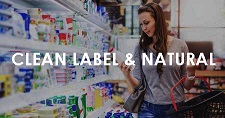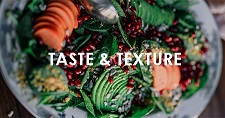What are hydrocolloids and how do they work in product application?
“For the purposes of this interview, let’s call these products food gums because once you get into a discussion about what a hydrocolloid is, it tends to become very complicated and scientific. To me, a food gum is an extremely long-chain polymer which dissolves in water to produce solutions that are either thickening or gelling. When these therefore are added to a product, they will dissolve in the water phase, cause it to thicken or gel, and control the way the water moves due to either pressure or temperature.”
What kind of textures can be achieved with gums?
“Amongst the thickeners, you can achieve various textures ranging from so thin that you would think it is vegetable oil, to extremely thick that it will hardly flow. Some will be long, some short, some drip cleanly, and some pull. The gelling gums will produce gels ranging through all of the textures possible for gels, from elastic to brittle, or from melt in the mouth to chewy. Gels do not ‘do’ crispy.”
Is it hard to determine which gum to use?
“After 35 years working with them, I don’t find it so difficult to choose which to use anymore. Though, that is just the beginning. Knowing how something should work is not the same as knowing how to make it work.”
What are the main challenges in using gums?
“You mean, after having chosen the correct one for the job you want it to do? Some are easy, you just need to pay attention to avoiding lumps and maybe water temperatures. Others are, frankly, difficult. They may need de-ionised water, chelating agents and divalent cation sources. There are also occasional problems with the ionic gums interacting with other ingredients in an unexpected way, particularly proteins.”
“Apart from reading and learning as you go, I have found it very useful to have a few trusted advisers who, thankfully, are more interested in solving technical problems than making money out of me. (Thanks folks!)”
Which gums can be considered as ‘clean label’ or ‘natural’?
“I am probably going to annoy a few people with this, but I don’t believe that there are many ‘natural’ gums about. Unless they are simply ground up flours, like guar gum, most gums will have been extracted, cleaned, solubilised, precipitated out and possibly, chemically modified in some way. That includes gelatine. As you might expect, the more natural the gum, the less it does.”
What innovations are you seeing around textures and texturising agents?
“Sadly, very little that are truly innovative; though, I am working on two at this very moment. I think there are a lot of untapped potential applications for gums and of course, the synergies that come from combining them, can be really interesting. That said, simply relabelling is not innovative, nor is removing one and replacing it with five ‘clean label’ ingredients to do a worse job than the single one that is being replaced.”
What are your predictions for the F&B industry over the next 3-5 years?
“Long term, I love the idea of vertical farming, but I cannot see that coming soon enough to really help – though it has the combined auras of local and fresh. Shorter term, I think we are heading for a lot of problems with supply. This COVID issue is going to affect the supply of workers available to grow, harvest and process foods. Therefore, food security, sustainability, reducing food waste by using everything to the best of our ability, and continuing with the plant-based proteins are probably going to be the most important trends in the near future.”





